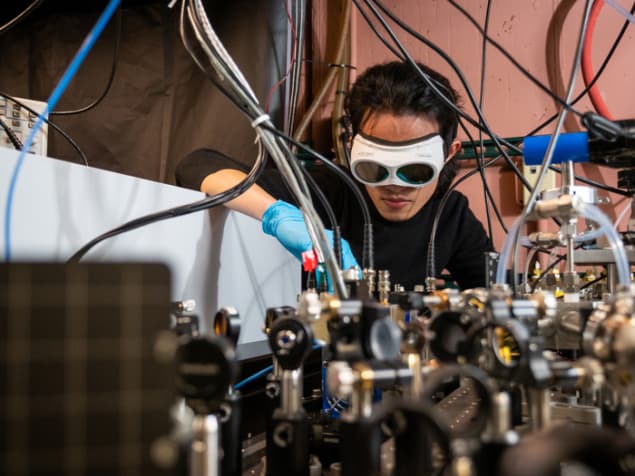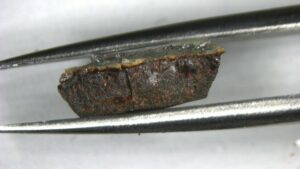
A new medical diagnostic tool based on the use of optical frequency comb technology can rapidly test for COVID-19 in exhaled breath. The technique, developed by researchers at JILA, the National Institute of Standards and Technology (NIST) and the University of Colorado Boulder, could also be used to diagnose other conditions or diseases, particularly those of respiratory, gastrointestinal or metabolic origin.
Being able to rapidly test for infection by viruses like SARS-CoV-2, the virus responsible for COVID-19, is crucial for fighting future pandemics. Testing exhaled human breath could come into its own here since each breath contains more than 1000 distinct molecules, some of which can indicate underlying medical conditions or infections. These molecules can be detected and identified by measuring their selective absorption of laser light at different optical frequencies.
In 2008, researchers led by Jun Ye of JILA demonstrated that frequency comb spectroscopy – a technique originally developed for optical atomic clocks and precision metrology – could potentially identify disease biomarkers in exhaled human breath. The technique, which essentially uses laser light to distinguish between different molecules, lacked sensitivity, however, and could not link specific molecules to disease states. They did not, therefore, test it to diagnose illnesses.
Parts-per-trillion level sensitivity
In 2021, Ye and colleagues improved the sensitivity of their technique by 1000 times, meaning that it could now detect certain biomolecules at the parts-per-trillion level. In their new study, detailed in the Journal of Breath Research, they applied supervised machine learning to process the light absorption patterns and make a direct connection to potential disease states without going through the intermediate step of identifying molecules first.
To test their method, the researchers collected breath samples from 170 individuals, half of whom had SARS-CoV-2 when tested using conventional PCR (polymerase chain reaction). They then piped in the samples through a tube into their new breathalyser, which consists of optical frequency combs that generate mid-infrared laser light at tens of thousands and sometimes hundreds of thousands distinct optical frequencies. Using a pair of high-reflectivity mirrors, the frequency comb light multi-passes the breath gas samples around 4000 times so that the molecular absorption strengths are significantly enhanced.
The team then used machine learning algorithms to analyse the ultrasensitive absorption signals measured at around 15000 frequencies to detect whether the subjects were infected or not. The study was verified by asking the machine to predict the COVID status of each individual and then comparing this to the results from their PCR test.
An alternative to PCR tests
The results from the new laser spectroscopy technique matched 85% of the those from PCR, which is “excellent” according to medical diagnostic standards.
“The technique could be an alternative to PCR tests for COVID-19,” says study lead author Qizhong Liang. “The laser-based breath test is much faster at obtaining the result and in future systems we are implementing a real-time detection capability by asking people to breathe directly into our apparatus.”

Physicists simulate how SARS-CoV-2 forms
The detection is also, of course, non-invasive – in contrast to the nasal swabs that we all have bad memories of from the pandemic. “It might thus encourage more people to get tested,” he says. “Another interesting note is that the breath sample remains intact after the test, allowing time-dependent studies on these samples if there is future interest.”
The JILA team will now be looking into the applicability of the technique to diagnose other conditions or diseases, particularly those of respiratory, gastrointestinal or metabolic origin. Indeed, they are setting up a collaboration with paediatricians to analyse the breath of asthmatic children. They also plan to reduce the dimensions of the instrument, which is currently metres in size.
“We have extended the spectral coverage of the method to allow for the detection of many more molecules,” Ye tells Physics World. “In this way, we can detect even more chemical information from breath and further improve diagnostic accuracy.”
- SEO Powered Content & PR Distribution. Get Amplified Today.
- EVM Finance. Unified Interface for Decentralized Finance. Access Here.
- Quantum Media Group. IR/PR Amplified. Access Here.
- PlatoAiStream. Web3 Data Intelligence. Knowledge Amplified. Access Here.
- Source: https://physicsworld.com/a/novel-breathalyser-rapidly-tests-for-covid-19/
- :is
- :not
- $UP
- 2008
- 2021
- a
- Able
- According
- accuracy
- After
- algorithms
- All
- allow
- Allowing
- also
- alternative
- an
- analyse
- and
- applied
- ARE
- around
- At
- author
- Bad
- based
- BE
- between
- Breath
- BREATHE
- by
- CAN
- candidate
- certain
- chain
- chemical
- Children
- Clocks
- collaboration
- colleagues
- Colorado
- come
- comparing
- conditions
- connection
- consists
- contains
- contrast
- conventional
- could
- Course
- coverage
- Covid
- COVID-19
- crucial
- Currently
- demonstrated
- demonstrates
- detailed
- detected
- Detection
- developed
- DID
- different
- dimensions
- direct
- directly
- Disease
- diseases
- distinct
- distinguish
- each
- encourage
- enhanced
- essentially
- Even
- faster
- fighting
- First
- For
- formation
- Frequency
- from
- further
- future
- GAS
- generate
- get
- going
- had
- Half
- Have
- he
- here
- How
- However
- HTTPS
- human
- Hundreds
- identified
- identify
- identifying
- if
- image
- implementing
- improve
- in
- indicate
- individual
- individuals
- infections
- information
- Institute
- instrument
- interest
- interesting
- into
- issue
- IT
- ITS
- jpg
- lab
- laser
- lead
- learning
- Led
- Level
- light
- like
- LINK
- looking
- machine
- machine learning
- make
- many
- matched
- max-width
- meaning
- measuring
- medical
- Memories
- method
- Metrology
- might
- molecular
- monitoring
- more
- much
- nasal
- National
- New
- nist
- novel
- now
- obtaining
- of
- on
- or
- origin
- originally
- Other
- our
- own
- pair
- pandemic
- Pandemics
- particularly
- patrick
- patterns
- People
- Physics
- Physics World
- plan
- plato
- Plato Data Intelligence
- PlatoData
- potential
- potentially
- Precision
- predict
- process
- rapidly
- reaction
- real-time
- reduce
- remains
- researchers
- responsible
- result
- Results
- SARS-CoV-2
- says
- selective
- Sensitivity
- setting
- signals
- significantly
- since
- Size
- So
- some
- specific
- Spectral
- Spectroscopy
- standards
- States
- Status
- Step
- strengths
- studies
- Study
- Systems
- team
- Technology
- tells
- tens
- test
- tested
- Testing
- tests
- than
- that
- The
- their
- then
- There.
- therefore
- These
- they
- this
- those
- thousands
- Through
- thumbnail
- times
- to
- tool
- true
- underlying
- university
- use
- used
- uses
- using
- verified
- virus
- viruses
- was
- Way..
- we
- were
- when
- whether
- which
- will
- with
- without
- works
- world
- Ye
- zephyrnet












